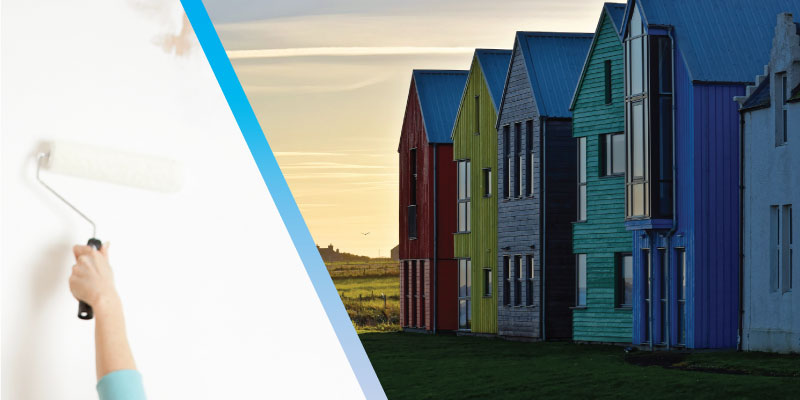Your outside house walls looking a little tired and your paint is peeling? It’s time for a new paint job. You don’t want the peeling to continue and bring damage to your walls due to exposure to the elements. If you already have wall damage, call The 2 Men Property Services. Repainting the outside of your house before serious damage happens is vital.
What type of paint should you use?
There are two types of paints generally used outside. One is water-based and the other is oil-based. The pros of water based exterior paints is that it responds well to temperature changes outside. It dries fast, and is resistant to moisture. The pros of using oil-based paints is that if you have metal or wood that tends to bleed, it will stop the bleeding and holds on to metal better than water-based paints. It will stay on your walls longer and goes deeper into your walls than water-based paint. If you’re repainting a wall and if the wall already has been painted with water based paint a long time ago, it is best to use water-based paint again on the wall instead of oil-based for the new paint job. The same rule applies if the outside walls have already been painted with multiple layers of oil-based paints before. It’s best not to paint over it with water-based paint. Like regular oil and water don’t mix, oil-based and water-based paints don’t go well layered together.
If you’re working with raw outside wall materials that haven’t been painted before, you have to put a primer on it. Again, use primers according to the paint finish you will use. Water-based primers go with water-based finish paint and oil-based primers go with oil-based finish paint. If there are exposed metals, wood, or cement use primers that are for each specific material.
There are three types of finishes you can choose from. You can get a matte look which is great for hiding ugly spots and great for siding. The gloss look is very shiny and is the easiest to get dirt and dust off. It’s great to use for fine details on the outside of your house like doors and outside trim. It’s not the best for siding or regular walls outside. Satin is a mix of both worlds. It’s not so shiny and not so matte. If you’re looking for very specific paint and color for your house, you can get your local paint store to mix you your own special batch of paint specifically designed to suit your outdoor painting needs. Just make sure you have enough to finish with and enough left over for minor repairs later. Make sure you read the directions for use before applying the paint.
If the paint has been sitting a while at the hardware store, mix the paint well or ask your local paint store to mix it for you with their mixing or shaking machines.
How can you prepare the outside of your house for painting?
Scrape, brush, and sand off peeling paint. If any repairs must be made, fix them before painting as leaving it will take more work later. You can use a pressure spray days before painting to get dirt and dust off completely. Make sure your wall is completely dry before painting and the weather will be good on the days you paint. Make sure all nails or screws are completely below the wall surface and if there are holes, fill them up with exterior putty so the heads of nails, screws, and construction staples won’t show. For smaller surface areas, trims, or edges, use brushes of different lengths according to the size of the area. For larger surface areas, use a roller. It’s best to paint on the shaded part of the house first and move as the sun moves. Start from top to bottom. Move your ladder as you go. Don’t overextend yourself as you can fall and injure yourself seriously. Make sure your hips are square with the ladder and facing the ladder at all times.
< Back to our Brisbane Handyman page

